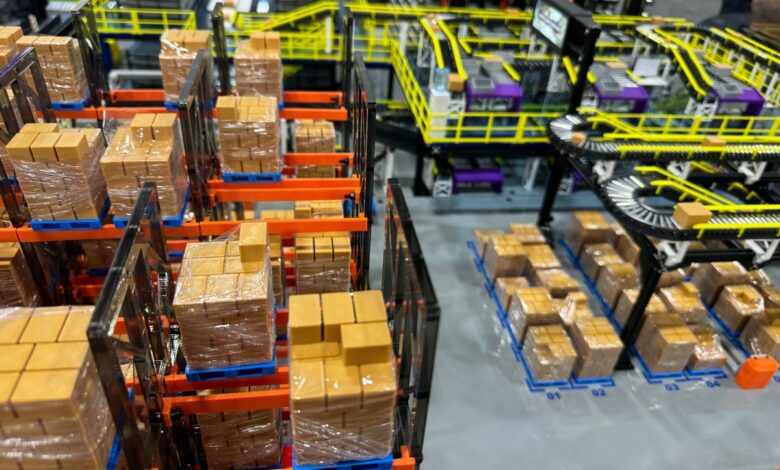Humanoid robots face continued skepticism at Modex

If your robotics startup is looking to raise, there’s close to a 100% chance you’re going to get two questions from potential investors: 1) How are you incorporating generative AI? and 2) Have you consider building a humanoid? The first is easy enough to answer. If you’re running a robotics firm in 2024, you have almost certainly experimented with incorporating generative AI into your workflow.
The second is one of those investor questions that requires you look thoughtfully and say something like, “you know, humanoids have potential, but aren’t well-suited for this particular challenge.” Then you jingle a set of keys and attempt to quickly switch subjects. It’s not a flat-out refutation of the form factor, so much as an acknowledgement that — in spite of investor enthusiasm — it’s not the ideal tool for every job.
It’s reasonable to suspect that we’ve entered the apex of the robotic hype cycle. Figure’s recent $675 million raise dropped countless jaws across the industry and left open the question of just how sustainable this market is. This week’s Modex supply chain show in
Atlanta told its own story — one populated by very few humanoids.
Precisely two were present among the Georgia World Congress Center’s three massive halls. Most prominent was Agility. In a repeat performance of last year’s ProMat event, the firm drew massive crowds throughout the week. This time, Digit showed off upgraded hands, new software and a workflow developed for automotive manufacturing. There’s been a good bit of progress since last year’s event, from product to executive staff to serious conversations about things like ROI.
Agility currently stands alone in terms of go-to-market progress. Conversations about Digit feel less theoretical than much of the humanoid competition, but questions of real-world deployment remain. A number of the people I spoke with at the show this week made sure to use the word “PILOT” (full-caps) to distinguish smaller-scale trial deployments from wider-scale adoption. Piloting isn’t a dirty word in this industry (nor is it unique to humanoids), it’s a standard and sensitive thing to do with new technology.
It’s more that pilots are trials and should be regarded as such. There’s a big gulf between a company piloting a handful of devices and being so committed to a new technology that you overhaul your manufacturing or warehouse processes to incorporate it. The two are connected, of course, as the former is generally required to achieve the latter, but coverage can be too eager to conflate the two. There are countless examples of pilots that never graduated to full-scale deployment for any number of reasons.
A big part of the reason pilots get as much play as they do is that they’re generally beneficial for both parties. The company selling the product gets — if not validation, then at least clear interest from a well-established corporation. The corporation, meanwhile, signals to shareholders and customers that it’s up on the latest technologies that could get it a leg up on the competition in this cut-throat world of late-capitalism. Pilots are absolutely worth tracking and do signal important milestones for startups, but at the end of the day, deployment numbers are the real thing to track.
A number of the players I spoke with continued to express skepticism around the widespread adoption of humanoid robots in the workplace. As always, it’s important to take this stuff with a grain of salt and consider the source. If your company manufacturers robotic arms and/or AMRs (autonomous mobile robots), you no doubt have a vested interest in believing that those form factors will continue to dominate the field as they have for decades.
Over the past week, however, I’ve noticed a shift in conversations versus last year. It could well be the progress companies like Agility have made, in terms of technology, customer interest, fund raising and the continued hiring of very smart people. Whatever the cause, pure skepticism around humanoids has softened for many. I heard very few outright rejections of the humanoid form factor. The standard response was close to measured optimism.
These same people now see a role for humanoids in the factory, but rather than outright replacing more traditional single-purpose systems, the robots will serve to augment them. Effectively, these robots would replace people in what are known as “human-in-the-loop” systems, which require non-machine intervention. Perhaps now is the time to start discussing humanoids-in-the-loop. For now, however, the human element is necessary.
People often point to this as evidence that automation doesn’t replace jobs. Many manufacturers also remain adamant that people will always have a role to play here. Earlier this week, Plus One Robotics CEO Erik Nieves told me the meaning behind the company’s name, noting, “you have to add a human if you’re going to increase the reliability over time.”
This stuff is impossible to predict completely, but that won’t stop us from trying — or having strong and unmovable opinions on the matter. This is one of those places where my skepticism/cynicism (depending on the day) is on full display. I believe it’s important to factor in capitalist motives. Seriously ask yourself: If such and such company could save pennies by completely automating their manufacturing and warehouse divisions, do you think they would hesitate to do so?
Lights-out factories are few and far between, but they do exist. Manufacturing is particularly suited to full automation, as it is a highly structured environment, built around extremely repetitive workflows. But while humans aren’t present in the day to day, edge cases will always exist. These instances, which now require human intervention, could be the ideal scenario for humanoids, whether operating autonomously or teleoperated, as in the case of Reflex, the other humanoid robotics firm present at Modex.
“If you start thinking about lights-out production, there’s always this 5% of exceptions that need to be handled,” GreyOrange CEO Akash Gupta told me during a conversation at the company’s booth this week. “I think that’s the role [humanoids] are going to play in warehousing. They’re going to plug that 5% exception gap, which needs a lot of dexterity and unstructured execution.”
Dexterity founding engineer Robert Sun pointed out to me earlier this week that the time frames may not ultimately sync up for wider humanoid robot deployments. He suggested that, while the form factor could play an important role in the move to lights-out factories and warehouses, the technology might not be where it needs to be in time for that to make a lot of sense.
“Transitioning all logistics and warehousing work to roboticized work, I thought humanoids could be a good transition point,” Sun explains. “Now we don’t have the human, so we’ll put the humanoid there. Eventually, we’ll move to this automated lights-out factory. Then the issue of humanoids being very difficult makes it hard to put them in the transition period.”
The timeline is key here. After all, many of these systems are being positioned as “general purpose,” though anyone who knows the space understands that this promise is a ways off. The question, ultimately, is how invaluable these systems can make themselves in the meantime. That’s precisely why these pilots are important — it’s also why much of the messaging has shifted to ROI.
Humanoid robotics firms can promise the world down the road, and certainly the form factor is significantly more adaptable than many or most of the single-purpose systems that currently dominate warehouse and factory floors. Ultimately, however, bridging the gap between now and then will require systems that can prove their value from day one.
Source link




